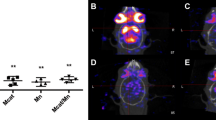Summary
1. In experiments on rats and mice, paraoxon (E 600) was found to be less effective on intraperitoneal than on intramuscular injection: on intraperitoneal injection, the lethal dose (LD50) as well as the dose causing 50% inhibition of the brain cholinesterase (ED50) were about four times higher than on intramuscular injection (“detoxication by passage through the liver”).
2. Parathion (E605), on the other hand, was less effective on intramuscular than on intraperitoneal injection: on intramuscular injection, the LD50 as well as the ED50 were nearly twice as high as on intraperitoneal injection (“toxification by passage through the liver”).
3. The anticholinesterase agent 217-AO lost only little of its effectiveness by passing the liver following an intraperitoneal injection. In vivo, 217-AO was more effective than paraoxon, although 25 times higher concentrations are needed to inhibit the cholinesterase in vitro.
The results suggest that paraoxon is detoxicated by the liver so quickly that only a small fraction of the injected amount becomes effective, and that the “toxification” of parathion in the liver takes place more quickly than the detoxication of the paraoxon formed.
4. Dopamine was destroyed in the liver so quickly (monoamino-oxydase) that the intraperitoneal injection of a dose was ineffective which, on intramuscular injection, caused a strong rise in blood pressure.
5. Hexobarbital (Evipan) was destroyed in the liver so slowly (enzymes in the microsomes) that intraperitoneal and intramuscular injections were equally effective.
The different behaviour of the last two substances shows that it depends on the velocity of the inactivation in the liver whether or not there is a difference in effectiveness between intraperitoneal and intramuscular injections.
Similar content being viewed by others
Literatur
Davison. A. N.: The conversion of schradan (OMPA) and parathion into inhibitors of cholinesterase by mammalian liver. Biochem. J. 61, 203 (1955).
Diggle. W. M., and J. C. Gage: Cholinesterase inhibition in vitro by OO-diethyl-O-p-nitrophenylthiophosphate (parathion, E605). Biochem. J. 49, 491 (1951).
Cholinesterase inhibition by parathion in vivo. Nature (Lond.) 168, 998 (1951).
Dirnhuber. P., and H. Cullumbine: The effect of anti-cholinesterase agents on the rat's blood pressure. Brit. J. Pharmacol. 10, 12 (1955).
Erdmann. W. D., u. L. Lendle: Toxicität und Elimination von esteraseblockenden Alkylphosphaten und Eserin bei Dauerinfusionen. Naunyn-Schmiedeberg's Arch. exp. Path. Pharmak. 230, 208 (1957).
Vergiftungen mit esteraseblockierenden Insecticiden aus der Gruppe der organischen Phosphorsäure-Ester (E 605 und Verwandte). Ergebn. inn. Med. Kinderheilk. 10, 104 (1958).
Fouts. J. R., and B. B. Brodie: On the mechanism of drug potentiation by iproniazid (2-isopropyl-1-isonicotinyl hydrazine). J. Pharmacol. exp. Ther. 116, 480 (1956).
Holtz. P., H. Balzer u. E. Westermann: Beeinflussung der Narkosedauer durch Hemmung der Cholinesterase des Gehirns. Naunyn-Schmiedeberg's Arch. exp. Path. Pharmak. 233, 438 (1958).
Holtz. P., H. Balzer, E. Westermann u. Eveline Wezler: Beeinflussung der Evipannarkose durch Reserpin, Iproniazid und biogene Amine. Naunyn-Schmiedeberg's Arch. exp. Path. Pharmak. 231, 333 (1957).
Hornkiewicz. O., u. W. Kobinger: Über den Einfluß von Eserin, Tetraäthylpyrophosphat (TEPP) und Neostigmin auf den Blutdruck und die pressorischen Carotissinusreflexe der Ratte. Naunyn-Schmiedeberg's Arch. exp. Path. Pharmak. 228, 493 (1956).
Koelle. G. B., u. E. C. Steiner: The cerebral distributions of a tertiary and a quarternary anticholinesterase agent following intravenous and intraventricular injection. J. Pharmacol. exp. Ther. 118, 420 (1956).
Kubistova. J.: Parathion metabolism in rat liver and kidney slices. Experientia (Basel) 12, 233 (1956).
Litchfield. J. T., and F. Wilcoxon: A simplified method of evaluating dose-effect experiments. J. Pharmacol. exp. Ther. 96, 99 (1949).
Varagic. V.: The action of eserine on the blood pressure of the rat. Brit. J. Pharmacol. 10, 349 (1955).
Wirth. W.: Zur Pharmakologie der Phosphorsäureester, Diäthyl-p-nitrophenylphosphat („Mintacol“). Naunyn-Schmiedeberg's Arch. exp. Path. Pharmak. 207, 547 (1949).
Zur Pharmakologie der Phosphorsäureester. Diäthylthiophosphorsäureester des Äthylthioglykol („Systox-Wirkstoff“). Naunyn-Schmiedeberg's Arch. exp. Path. Pharmak. 217, 144 (1953).
Zur Pharmakologie der insektiziden Phosphorsäureester. Dtsch. med. Wschr. 1954, 1205.
Author information
Authors and Affiliations
Additional information
Herrn Professor Dr. W. S. Loewe, Salt Lake City, zum 75. Geburtstag gewidmet.
Mit 2 Textabbildungen
Rights and permissions
About this article
Cite this article
Holtz, P., Westermann, E. Giftung und Entgiftung von Parathion und Paraoxon. Naunyn - Schmiedebergs Arch 237, 211–221 (1959). https://doi.org/10.1007/BF00244729
Received:
Issue Date:
DOI: https://doi.org/10.1007/BF00244729




